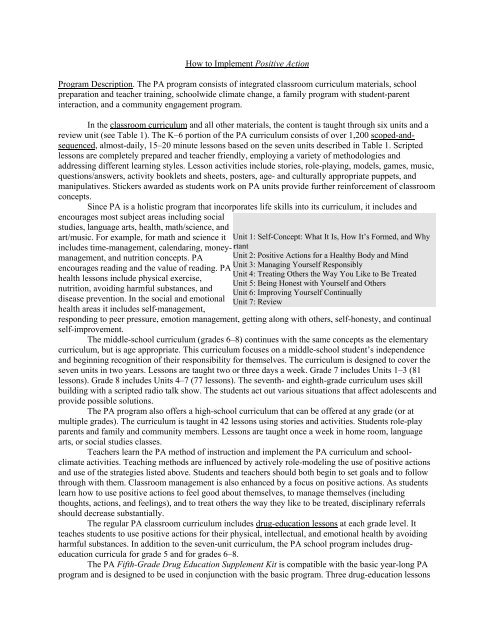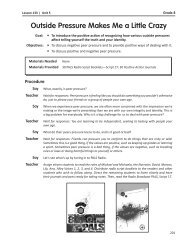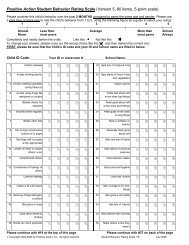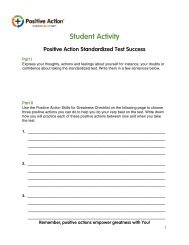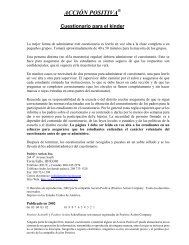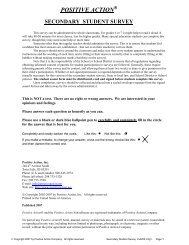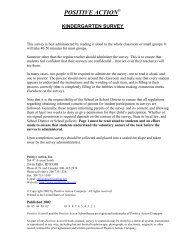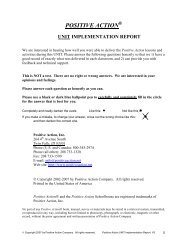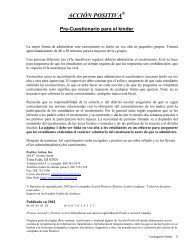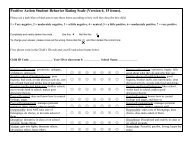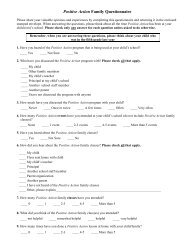How to Implement Positive Action Program Description. The PA ...
How to Implement Positive Action Program Description. The PA ...
How to Implement Positive Action Program Description. The PA ...
You also want an ePaper? Increase the reach of your titles
YUMPU automatically turns print PDFs into web optimized ePapers that Google loves.
<strong>How</strong> <strong>to</strong> <strong>Implement</strong> <strong>Positive</strong> <strong>Action</strong><br />
<strong>Program</strong> <strong>Description</strong>. <strong>The</strong> <strong>PA</strong> program consists of integrated classroom curriculum materials, school<br />
preparation and teacher training, schoolwide climate change, a family program with student-parent<br />
interaction, and a community engagement program.<br />
In the classroom curriculum and all other materials, the content is taught through six units and a<br />
review unit (see Table 1). <strong>The</strong> K–6 portion of the <strong>PA</strong> curriculum consists of over 1,200 scoped-andsequenced,<br />
almost-daily, 15–20 minute lessons based on the seven units described in Table 1. Scripted<br />
lessons are completely prepared and teacher friendly, employing a variety of methodologies and<br />
addressing different learning styles. Lesson activities include s<strong>to</strong>ries, role-playing, models, games, music,<br />
questions/answers, activity booklets and sheets, posters, age- and culturally appropriate puppets, and<br />
manipulatives. Stickers awarded as students work on <strong>PA</strong> units provide further reinforcement of classroom<br />
concepts.<br />
Since <strong>PA</strong> is a holistic program that incorporates life skills in<strong>to</strong> its curriculum, it includes and<br />
encourages most subject areas including social Table 1: <strong>Positive</strong> <strong>Action</strong> Unit Concepts<br />
studies, language arts, health, math/science, and<br />
art/music. For example, for math and science it Unit 1: Self-Concept: What It Is, <strong>How</strong> It’s Formed, and Why<br />
includes time-management, calendaring, money-ortant<br />
management, and nutrition concepts. <strong>PA</strong> Unit 2: <strong>Positive</strong> <strong>Action</strong>s for a Healthy Body and Mind<br />
encourages reading and the value of reading. <strong>PA</strong><br />
Unit 3: Managing Yourself Responsibly<br />
Unit 4: Treating Others the Way You Like <strong>to</strong> Be Treated<br />
health lessons include physical exercise,<br />
Unit 5: Being Honest with Yourself and Others<br />
nutrition, avoiding harmful substances, and<br />
Unit 6: Improving Yourself Continually<br />
disease prevention. In the social and emotional Unit 7: Review<br />
health areas it includes self-management,<br />
responding <strong>to</strong> peer pressure, emotion management, getting along with others, self-honesty, and continual<br />
self-improvement.<br />
<strong>The</strong> middle-school curriculum (grades 6–8) continues with the same concepts as the elementary<br />
curriculum, but is age appropriate. This curriculum focuses on a middle-school student’s independence<br />
and beginning recognition of their responsibility for themselves. <strong>The</strong> curriculum is designed <strong>to</strong> cover the<br />
seven units in two years. Lessons are taught two or three days a week. Grade 7 includes Units 1–3 (81<br />
lessons). Grade 8 includes Units 4–7 (77 lessons). <strong>The</strong> seventh- and eighth-grade curriculum uses skill<br />
building with a scripted radio talk show. <strong>The</strong> students act out various situations that affect adolescents and<br />
provide possible solutions.<br />
<strong>The</strong> <strong>PA</strong> program also offers a high-school curriculum that can be offered at any grade (or at<br />
multiple grades). <strong>The</strong> curriculum is taught in 42 lessons using s<strong>to</strong>ries and activities. Students role-play<br />
parents and family and community members. Lessons are taught once a week in home room, language<br />
arts, or social studies classes.<br />
Teachers learn the <strong>PA</strong> method of instruction and implement the <strong>PA</strong> curriculum and schoolclimate<br />
activities. Teaching methods are influenced by actively role-modeling the use of positive actions<br />
and use of the strategies listed above. Students and teachers should both begin <strong>to</strong> set goals and <strong>to</strong> follow<br />
through with them. Classroom management is also enhanced by a focus on positive actions. As students<br />
learn how <strong>to</strong> use positive actions <strong>to</strong> feel good about themselves, <strong>to</strong> manage themselves (including<br />
thoughts, actions, and feelings), and <strong>to</strong> treat others the way they like <strong>to</strong> be treated, disciplinary referrals<br />
should decrease substantially.<br />
<strong>The</strong> regular <strong>PA</strong> classroom curriculum includes drug-education lessons at each grade level. It<br />
teaches students <strong>to</strong> use positive actions for their physical, intellectual, and emotional health by avoiding<br />
harmful substances. In addition <strong>to</strong> the seven-unit curriculum, the <strong>PA</strong> school program includes drugeducation<br />
curricula for grade 5 and for grades 6–8.<br />
<strong>The</strong> <strong>PA</strong> Fifth-Grade Drug Education Supplement Kit is compatible with the basic year-long <strong>PA</strong><br />
program and is designed <strong>to</strong> be used in conjunction with the basic program. Three drug-education lessons
are presented after completing each of the six basic units. <strong>The</strong> drug-education lessons reinforce basic <strong>PA</strong><br />
concepts and apply those concepts <strong>to</strong> prevent drug use. <strong>The</strong> grade 5 lessons provide in-depth information<br />
about the consequences of drug use, relate them <strong>to</strong> each <strong>PA</strong> unit, and teach students that the key <strong>to</strong> a<br />
happy and healthy life is being drug-free. It is designed <strong>to</strong> be used along with the regular fifth-grade <strong>PA</strong><br />
curriculum, but it also works well by itself.<br />
<strong>The</strong> middle-school curriculum also includes a Middle-School Drug Education Supplement<br />
Teacher’s Kit. <strong>The</strong> kit contains a Teacher’s Manual, 10 Escape from the Shadow script booklets, 30<br />
Student Activity Booklets, “Take the Challenge!” game, “Choices and Consequences” game, one ninepart<br />
mural, three individual posters, 6 Vital Signs Kits, handouts, bookmarks, “Hold On <strong>to</strong> Your<br />
Dreams!” cassette tape and sheet music, and hands-on materials. <strong>The</strong> program encourages middle-school<br />
students <strong>to</strong> reach for their dreams while helping them understand how drug use limits their potential and<br />
choices. It reinforces/reveals how drugs affect students’ physical, intellectual, and emotional well-being<br />
and establishes the benefits of being drug-free. This program is useful in both preventive and remedial<br />
programs. It is designed <strong>to</strong> be incorporated in<strong>to</strong> the <strong>PA</strong> curriculum, but it is used successfully as a standalone<br />
program also.<br />
<strong>PA</strong> is a highly interactive and engaging program that uses modeling, skill building, and positive<br />
reinforcement <strong>to</strong> motivate and teach the concepts. <strong>The</strong> activities are appropriate by grade and<br />
developmental level. For example, flannel-board activities, puppets, and hands-on games actively involve<br />
kindergarten students in <strong>PA</strong> lessons. An example of age-appropriate activities for the upper grades would<br />
be a radio drama for middle-school students that helps this age group empathize with the problems related<br />
<strong>to</strong> substance use. Another example of an activity specifically designed for middle-school students is the<br />
Self-Concept Scientist booklet. By using these booklets, a student can individually chart changes and<br />
development in his or her self-concept. Further reinforcement comes through the ICU (I See You Doing<br />
Something <strong>Positive</strong>) Boxes. By putting notes in boxes <strong>to</strong> commend the positive actions of others,<br />
everyone in the school has a chance <strong>to</strong> recognize and document positive actions.<br />
<strong>The</strong> schoolwide climate-change program reinforces the curriculum learning by coordinating the<br />
efforts of the entire school in practicing positive actions <strong>to</strong> promote improved behavior and performance.<br />
<strong>The</strong> school-climate program is designed <strong>to</strong> coordinate the efforts of the entire school population in<br />
practicing positive actions, thus magnifying the effects of the curriculum. <strong>The</strong> school-climate activities<br />
are inclusive, varied, and comprehensive, serving all students including those learning English as a<br />
second language, low-income students, and students with disabilities. <strong>PA</strong> schools are strongly encouraged<br />
<strong>to</strong> adapt and adopt the activities that best serve both individual populations of students and the student<br />
body as a whole.<br />
<strong>The</strong> <strong>PA</strong> program for school-climate change also supports the counselor’s role in creating a<br />
positive school climate. <strong>The</strong> <strong>Positive</strong> <strong>Action</strong> Counselor’s Kit (Allred, 1997) contains suggestions and<br />
materials for counseling activities for the whole school, individual classrooms, small groups, and<br />
individual sessions. <strong>The</strong> Counselor’s Kit is both educational and therapeutic and teaches daily life skills<br />
that students may not have learned previously (Allred, 1998). <strong>The</strong>se materials are also appropriate for<br />
peer tu<strong>to</strong>ring, family simulations, and parent involvement.<br />
Some examples of activities engaging the entire school are the Words of the Week, <strong>PA</strong><br />
assemblies, celebrations, and posters. Students, school staff, parents, and community members<br />
representing a variety of regular, ethnic and linguistic groups are specifically included in school-climate<br />
activities through the use of the Words of the Week and posters in their native languages. <strong>The</strong>se same<br />
ethnic and linguistic populations can reinforce <strong>PA</strong> concepts at celebration days for cultural or ethnic<br />
groups. <strong>PA</strong> school-climate activities may also be cus<strong>to</strong>mized and adapted for groups of special-needs<br />
students, parents, and community volunteers.<br />
A schoolwide club for middle-school students is a subsidiary of the International <strong>Positive</strong> <strong>Action</strong><br />
Leaders (<strong>PA</strong>LS). Every student, teacher, support-staff member, and administra<strong>to</strong>r in the school becomes a<br />
member of the <strong>PA</strong>LS Club. <strong>The</strong> purpose of the <strong>PA</strong>LS Club is <strong>to</strong> provide a vehicle for students <strong>to</strong><br />
participate in meaningful positive actions and community service. <strong>The</strong> <strong>PA</strong>LS club is also the leadership<br />
and oversight body that encourages <strong>PA</strong>LS group and individual positive actions.
<strong>The</strong> <strong>PA</strong> parent and community involvement program provides ways for parents and other<br />
community members <strong>to</strong> participate in children’s educational processes and contribute <strong>to</strong> educational<br />
opportunities/issues within the community. Parents are provided with a parallel curriculum, the <strong>Positive</strong><br />
<strong>Action</strong> Family Kit where lessons are coordinated with and reinforce the classroom lessons. Parents are<br />
invited <strong>to</strong> participate by reviewing worksheets, by reading the school <strong>Positive</strong> <strong>Action</strong> newspaper, and <strong>to</strong><br />
act as men<strong>to</strong>rs, volunteers, cheerleaders, and chaperones for school activities. Parenting classes and<br />
support groups are also provided.<br />
Parents also participate in community partnerships, such as the <strong>PA</strong> Task Force, that address issues<br />
in the community that influence student well-being and provide a link <strong>to</strong> community organizations and<br />
businesses. Community members are also invited <strong>to</strong> work on improving education by working on the <strong>PA</strong><br />
Committee, acting as links <strong>to</strong> community organizations, serving as men<strong>to</strong>rs and role models for students,<br />
helping students with community service projects, serving on the <strong>PA</strong> Community Task Force, and<br />
providing linkages <strong>to</strong> social-service agencies, businesses, health-care and educational institutions, the arts,<br />
and the media. A community task force may choose <strong>to</strong> address specific community issues that affect<br />
student well-being, such as drug use or violence in school neighborhoods.<br />
<strong>PA</strong> has been researched and evaluated in every kind of school and location by the program’s<br />
developer, independent evalua<strong>to</strong>rs, and school districts. Evaluation designs have included<br />
experimental/control group, comparison group, national comparison group (e.g., changes in percentile<br />
rankings), and matched case-control studies. Multiple studies have consistently found <strong>PA</strong> <strong>to</strong> be effective<br />
for improving achievement scores, attendance, and self-concept and for reducing drug use, violence of<br />
multiple kinds, and other problem behaviors (see Section 6.5 below for detail). It is noteworthy that most<br />
effects were robust across urban, suburban, and rural schools; ethnic groups; and levels of poverty and<br />
mobility rates (see Section 6). This is an exceptionally important finding, as intervention effects of other<br />
programs are often smaller in higher-risk schools. Results from middle schools without <strong>PA</strong> demonstrate<br />
that the effects of the <strong>PA</strong> program can carry on once <strong>PA</strong> graduates move in<strong>to</strong> middle school.<br />
Evaluation results have also confirmed our belief that <strong>Positive</strong> <strong>Action</strong> training of principals,<br />
teachers, and other school staff is of critical importance. Effects of <strong>PA</strong> on students achievement,<br />
absenteeism, violence, drug use, and other behavioral problems are all greatest when (a) schools receive<br />
<strong>Positive</strong> <strong>Action</strong> training and (b) continue active implementation of the <strong>Positive</strong> <strong>Action</strong> program.


